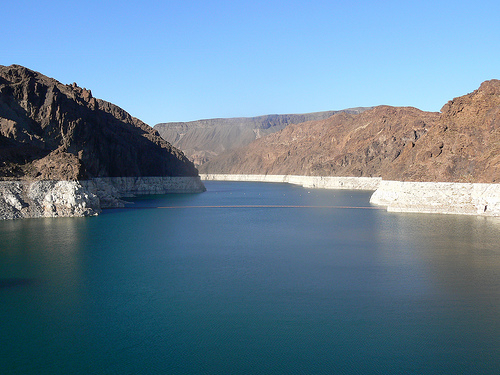 Calcium scale occurs everywhere. The photo on the right shows calcium carbonate scale lining the rock formations in Lake Mead, just above Hoover Dam. The calcium from this photo deposited as a result of dissolution of calcium in upstream limestone rock formations along the Colorado River, followed by evaporation and reprecipitation in Lake Mead. In a roundabout way, this is the same method that calcium scale forms in a scrubber. Calcium enters via the feedwater (Colorado River), concentrates due to evaporation (the hot Nevada sun), and forms a precipitate as the calcium concentration exceeds the solubility limit (lime deposits).
Calcium scale occurs everywhere. The photo on the right shows calcium carbonate scale lining the rock formations in Lake Mead, just above Hoover Dam. The calcium from this photo deposited as a result of dissolution of calcium in upstream limestone rock formations along the Colorado River, followed by evaporation and reprecipitation in Lake Mead. In a roundabout way, this is the same method that calcium scale forms in a scrubber. Calcium enters via the feedwater (Colorado River), concentrates due to evaporation (the hot Nevada sun), and forms a precipitate as the calcium concentration exceeds the solubility limit (lime deposits).
In my previous post, I detailed how to determine if calcium is a problem in your acid gas scrubber. Here, I will detail several methods for avoiding calcium scale and, when it arises, cleaning calcium scale.
Avoiding Scaling
The best way to tackle scaling is to avoid scaling. There are three basic methods to avoiding scale:
1. Remove the calcium
The easiest way to avoid calcium is to remove the calcium! First, try to select a feedwater that does not contain calcium. Condensates are often an excellent source of calcium-free feed water. If calcium-free water sources are not available, investigate the cost associated with a softener. Companies like Culligan offer a wide range of softeners. Water softening is a competitive market; there are often local suppliers that can offer low cost solutions.
2. Adjust the chemistry
There are several tricks that can be employed to permit higher concentrations of calcium in your scrubber water without leading to scale formation. For situations where calcium carbonate is the primary scale, you can decrease the pH of the scrubber. Acid gas removal efficiency decreases when operating at a lower pH, but the drop in efficiency can be overcome by increasing the packing height (and thus the number of transfer units). Decreasing the pH decreases the LSI index of the water; LSI indices less than 0 are non-scaling.
Companies like Nalco also sell anti-scalants that reduce the activity of the calcium ion in solution, thus eliminating the potential for calcium scale. Anti-scalants are usually much more expensive than acid treatment, but also permit operation at a higher pH which is more conducive to acid gas scrubbing.
3. Increase the blow down
In my previous post, I documented how the calcium concentration was tied to the blow down flow rate. One of the easiest and most practical solutions therefore is to increase the blow down flow rate. Increasing the blow down flow rate reduces the concentration of both the calcium and associate scaling anion (CO3, SO4, F) in the scrubber recirculation water. While increasing the blow down flow rate will add cost by increasing the feed water flow rate (to make up water removed in the blow down) as well as increasing sewer and other wastewater charges, it is often preferable as a quick fix solution for reducing scaling.
Coping with Scaling
In many ways, scaling is inevitable. A process upset, an exhausted bed, or a blocked blow down valve - these things happen. How do you remove the scale?
Calcium carbonate is the most common scale. It is also amongst the easiest to clean. Lowering the pH is the most aggressive way to dissolve the scale, though running at any LSI << 0 will tend to dissolve the calcium carbonate.
Calcium sulfate is another common scale, especially in an SO2 scrubber. The best method for removing calcium sulfate is using hot, low pH water to remove the scale. Calcium sulfate, like calcium carbonate, will dissolve. Chelants such as EDTA are also helpful for this form of scale.
Calcium fluoride is the worst scale to remove, since it has such a low solubility. Physical methods work best for calcium fluoride, as dissolving calcium fluoride is difficult. Some chelants such as EDTA are available on the market for removing calcium fluoride, but are not likely to be as effective as with other forms of scale.
To learn more about Envitech's acid gas scrubbers, please download our packed bed cut sheet.
Note: Photo of Lake Mead by Tim Pearce


